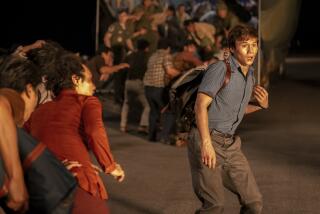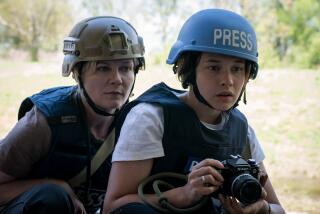Vietnam heartbreak
- Share via
When documentarians Gail Dolgin and Vicente Franco traveled to Da Nang, Vietnam, with Tennessee-raised Heidi Bub to film her reunion with her birth mother -- who sent 7-year-old Heidi to the United States at the end of the Vietnam War -- they thought they would be documenting a joyful experience.
Instead, Dolgin and Franco watched as the weeklong visit in 1997 ended in an emotionally charged family meeting where cross-cultural misunderstandings and misgauged expectations led to a meltdown for Heidi. The filmmakers were then faced with the tough decision of whether to keep the camera rolling.
“It was a very difficult moment for us,” Dolgin says. “We felt torn between extending ourselves with great compassion and comfort, and continuing to film the story that we had begun.”
They chose to stay true to their commitment to the truth. “We’re not out to gain glory by filming somebody’s tragedy,” Dolgin says, but she hopes that by filming what actually happened the documentary provides audiences “something we can all grow from, learn from, heal from.”
The resulting film, “Daughter From Danang,” won the Grand Jury Prize for best documentary at this year’s Sundance Film Festival. The critically acclaimed film opens in Los Angeles today exclusively at the Nuart and will air in April on PBS.
“Daughter From Danang” grew out of a casual conversation Dolgin had with her journalist friend Tran Tuong Nhu, who had recently made a trip to Vietnam to deliver a letter from Heidi to her birth mother, Mai Tai Kim. Heidi had been searching for her mother for several years when Nhu located her in the southern city of Da Nang.
Kim had feared that her Amerasian daughter, the progeny of an affair with an American naval officer at the military base where Kim once worked, would face danger when the war ended. Kim placed Heidi on a plane to America as part of “Operation Babylift” -- authorized by President Ford weeks before the fall of Saigon in 1975 -- which brought 2,000 Vietnamese “orphans” (many had living parents) to San Francisco.
Sensing an extraordinary story, Dolgin and Franco approached Heidi, asking to document her journey, and scrambled in six weeks to raise enough funds to cover their travel expenses. They met face-to-face with perky Heidi only the day before the flight, and Heidi was eager to share in detail her history of being raised in small town Pulaski, Tenn., where she says she became “101% Americanized.” Nhu easily secured the cooperation of Heidi’s Vietnamese relatives, and Kim was filled with pride and excitement that her daughter was returning.
Heidi, whose husband could not accompany her on the trip, gradually became overwhelmed by the intensity of meeting her long-lost birth mother and three half-siblings, as well as the culture shock and economic conditions in the city outskirts where they were living, and being away from her own two young daughters. When the relatives finally made a request for financial assistance -- by many accounts customary in Vietnamese culture of family members living abroad -- Heidi broke down in tears.
“She wasn’t able to understand that for her family, asking for the money didn’t mean that the love they were feeling for her was reduced in any way,” Dolgin says. In addition, Heidi, who was still feeling the pain of estrangement from her adoptive single mother, was not prepared to be obligated to relatives with whom she’d had no contact in 22 years. Upon her return to the United States, Heidi “felt that she had exposed herself so emotionally and wasn’t sure she wanted us to continue and share this profound, emotional vulnerability with the world,” Dolgin says.
The filmmakers put together for Heidi a 17-minute rough cut that included the most emotional scenes and told her they would abandon the project and give her the footage if that’s what she wanted. Although she felt embarrassed by her behavior and thought others would judge her harshly, Heidi encouraged them to proceed. She told the filmmakers that the project was helping her reexamine the trip and to “put all the pieces of the puzzle that had been floating around in my life together into one cohesive picture,” Dolgin says.
Dolgin and Franco sent Heidi a copy of the film as soon as it was completed, and Heidi couldn’t bring herself to watch it. After they called with the news of the Sundance award, she promised them she would. Weeks later she finally did, and she said to them, “It’s a very powerful film. It’s a good film. I just wish it wasn’t about me.”
“Daughter From Danang” was shot with one mini-DV camera by the bare-bones crew of Dolgin, Franco and a sound operator, to be as inconspicuous as possible. Dolgin and Franco, longtime working partners who first met at a film festival in Havana and co-directed the 1993 documentary “Cuba Va: The Challenge of the Next Generation,” say the final budget was around $350,000, not including a lot of donated equipment and time.
The response from audiences at film festivals has been very divided, both to Heidi and to how noble or solicitous the Vietnamese family is portrayed, even among Vietnamese American viewers. Some people have revised their opinion upon a second viewing, according to the filmmakers.
Nhu brought a tape of the film to Heidi’s relatives in Vietnam this summer. “It gave them an understanding of what kind of upbringing [Heidi] had” and how that informed Heidi’s reaction, Franco says. Nhu also brought a short letter from Heidi, her first correspondence to her family since the visit.
“So far, [Heidi] is unable to get to the point at which she feels comfortable with her own past, with the trip and with the results of it,” Franco says. “We like to believe that the journey will continue and, hopefully, it will be a positive continuation from the damage that was,” Dolgin adds.
Nhu also brought some money to the Vietnamese family sent by Dolgin and Franco, and Kim told Nhu she would use some of it to buy a telephone. Notes Dolgin: “She said she’s going to sit by the phone and hope that someday it will ring and she’ll answer it and she’ll hear a voice say, ‘Hello, mother.’ ”
More to Read
Only good movies
Get the Indie Focus newsletter, Mark Olsen's weekly guide to the world of cinema.
You may occasionally receive promotional content from the Los Angeles Times.










